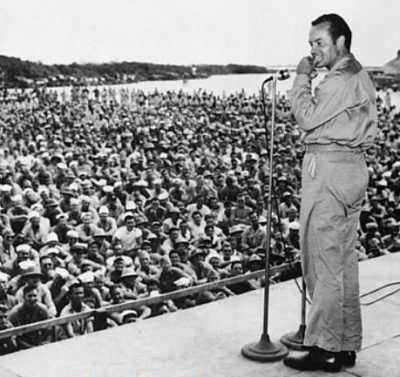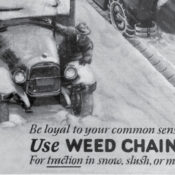After the attack on Pearl Harbor on December 7, 1941, it seems like the entire United States mobilized in some way for the war effort. Men enlisted, women joined the workforce, and kids collected cans and their old comics for recycling and war bond drives. But months before the U.S. was pulled into the war, entertainers had already found a way to contribute with their talents; after President Franklin D. Roosevelt put out the call for moral support for American G.I.s, Mary Ingraham answered by founding the United Service Organizations, better known as the USO. For 80 years now, the USO has traveled around the world to entertain the troops, serving an estimated 35 million Americans in that time. Here’s how the show got started.
Mary Shotwell Ingraham graduated from Vassar College and was the president of Brooklyn’s YWCA for years. By 1940, she had moved up to the organization’s National Board. Upon Franklin’s request for services for the troops, Ingraham’s organization came together with five others (the YMCA, the National Jewish Welfare Board, the Salvation Army, the National Travelers Aid Association, and National Catholic Community Service) to establish the United Service Organizations. Roosevelt thought that the group could boost morale for the troops and also put together recreation activities for soldiers on leave. The USO was formally incorporated on February 4, 1941.

After the group was founded, USO centers proliferated across the country. The various locations hosted dances, movies, live music, and more. Free coffee and doughnuts for troops was a regular feature. However, the most common image conjured when one hears USO is that of the traveling shows that took big-name entertainers right to the men in uniform.
The USO Camp Shows kicked off in October of 1941, two months before American’s entry into World War II. The live events were basically variety shows that featured combinations of singers, comedians, actors, bands, and more. While local and volunteer talent might be found on the bill, stars of huge magnitude soon gravitated to the events. By November, Camp Shows took a stab at going outside the U.S. with a visit to troops in the Caribbean. As the war began and the calendar turned, over 180 theaters for military shows were operating the U.S.; by the end of 1942, 70 units of performers were making their way around a circuit that included North and South America, the United Kingdom, and Australia.

One of the entertainers who would become inextricably linked with the USO was Bob Hope. His first show for the group was in California on May 6, 1941. Hope would do 57 USO tours, including 48 Christmas shows, going out during every major conflict that the U.S. was involved with for the rest of the 20th Century, including World War II, the Korean War, the Vietnam War, the Lebanese Civil War, the Iran-Iraq War, and the Gulf War. Hope negotiated a deal with NBC and the network carried dozens of specials assembled from footage shot during his tours. Among the other big names that went out were Irving Berlin, Rita Hayworth, and Judy Garland. Shortly after D-Day, the USO sent entertainers to Normandy to entertain troops that had made the landing and secured the beaches.
Inside today’s USO Centers (Uploaded to YouTube by USO)
The USO continues today, and its legacy has taken a firm hold not only in daily lives of servicemen and women, but in the popular consciousness and culture of the United States. The Golden Globe and Emmy-winning series China Beach featured a USO entertainer played by Chloe Webb in its first season. For the Boys starred Bette Midler and followed 50 years in the life a performer that did USO tours. More recently, Captain America: The First Avenger had a subplot where Cap spent several months doing USO shows before he was allowed to undertake missions in the field.
Presently, the USO makes its headquarters in Arlington, Virginia, and lists more than 200 centers around the world. Classified as a 501(c)(3) non-profit, the organization has 300 paid staff and boasts more than 44,000 volunteers. In 2011, the USO was awarded the National Medal of Arts. The USO may not be an actual government agency, but for 80 years, it’s done an incalculable service for those who serve.
Featured image: Marilyn Monroe in Korea with the USO in 1954 (U.S. Department of Defense photo via WikiMedia Commons; public domain)
Become a Saturday Evening Post member and enjoy unlimited access. Subscribe now




Comments
I think I may have found the original photo from Marilyn Monroe South Korea tour with Joe DiMaggio I think I have the original picture black and white with the numbers on the back is s 119 please get back to me as soon as possible I need to know if it was stolen or if I have a great find and I’d like to sell it or give it back to him it belongs to thank you very much my name is Joshua santschi
I remember going to the USO when I was in the Army, Cold War era, and in NYC, and getting tickets for Broadway shows. Later was stationed at Thule, Greenland, defending the Air Force with our Nike missiles, missed Bob Hope, he had been there the year before.
Mr. Brownfield I know the USO had good intentions with the kind of variety shows you mentioned, including the big bands. I’ve always been disappointed in Bob Hope for his emphasis on the women you and then Bob mention in his comments. He must love them too or wouldn’t have mentioned them. It makes me uncomfortable that the service men didn’t have more wholesome entertainment like the big bands. I don’t care for Angie Dickinson. Johnny Carson would have her on his show frequently for no real reason at all. It’s never made sense to me. I think Bob Hope and Johnny Carson were both lecherous men and Angie loved the attention. She’d encourage their flirting with her laughter and flirting back. Shame on all of them for their shameful ways, but especially her. She could have declined their invitations but didn’t.
I’ve really learned a lot here about the USO and what a force of good it still is after 80 years. I’m glad it started in advance of America’s forced deep dive into World War II after Pearl Harbor. They had time to hone and refine what would become so crucial over the next 4 years, and in the wars since.
Morale and hope are so important especially for the men and women putting their lives on the line, every day. Who would have been better suited to make the guys laugh and give them some fun from home than Bob Hope? NO ONE! He knew exactly what to do, and did so up into his 90s IN the ’90s! The best of the best in show biz, too. From Rita Hayworth to Brooke Shields, Marilyn, Nancy Sinatra, Angie Dickinson, and so many more. Incredible!
I’ve just added the USO to my list of organizations to help in addition to the ASPCA, St. Jude’s and Operation Smile.